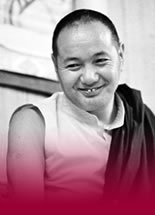Robina’s Blog
21 July, 2022
In Mahamudra Lama Yeshe talks about how the mind functions as a mirror: it reflects what’s out there. This is how it cognizes things. There is mind here – subject – and then there are objects of the mind, the things that mind cognizes – the world out there, including ourselves.
As Lama Zopa Rinpoche puts it, what’s out there is reflected back to us in the aspect of whatever’s in our mind. So if the mirror is cracked, or dirty, whatever is reflected appears wrongly, doesn’t it?
That tree on the riverbank appears accurately when the water is still and clear but when it’s turbulent, the tree appears crooked. We know this. But we always believe in what we see because we don’t think our mind plays any role. This is pretty shocking: we don’t think our mind plays any role at all in how things appear to us!
We really believe there is an intrinsically delicious cake out there on that plate, and I’m this innocent victim and it’s just begging me to eat it! But it’s clear that if our mind, our mirror, is polluted by attachment or anger or low self-esteem or arrogance, whatever appears to us will appear distorted.
If we think about this, it’s pretty sobering. We’re not seeing reality at all; we’re seeing our own projections, as we say in the West. So if there's lots of attachment in the mind – emotional hunger, dissatisfaction, I don't have enough – the cake appears back to us as delicious and we believe it, we believe what the mirror shows us. It's in this way, Buddha says, that we are literally never in touch with reality, even conventional.
I mean, at the simplest level, we’re right: it is a cake, but the rest of it's made up (well, finally, even the cake is made up). Attachment makes it look more delicious than it is, and, after five pieces, aversion makes it look more disgusting than it is. All the time, everything out there is appearing back to us in the aspect of whatever's in our mirror.
But forget about that. Even just the way we don’t get it right when it comes to our sensory consciousness is already an eye-opener. The mind functions both through sensory consciousness and mental consciousness. When my eyes turn toward that Thermos there I will say, “Wow, what a nicely designed Thermos,” and we just take it for granted that it’s my eyes that see the nicely designed Thermos. Not possible!
Our eye consciousness, which is that part of our mind, which is necessarily not physical – mind is not physical – that functions through the medium of the eyeball and all the physical bits and pieces, is extremely limited in its capacity for cognition; all the sensory consciousnesses are. Eye consciousness can cognize precisely two things: shape and color.
So the obvious question is, which part of my mind is cognizing “a nicely designed Thermos?” It’s the mental consciousness: that’s where the workshop is, as Lama Zopa Rinpoche says. That’s where everything I’ve ever thought about, seen, tasted, touched, heard or smelled – since beginningless time, by the way! – is stored as memories and imprints. So the moment my eyes land on that shape and color, quicker than Google a series of thoughts, opinions, viewpoints about it will instantly arise and out of my mouth come the words, “What a nicely designed Thermos.” A story made up by my mind based upon my habits, conditioning, prejudices, etc., etc. A mental construct.
But as far as I’m concerned, it’s objective truth! This is how we live our lives, stumbling along, believing in our own karmic appearances, as Rinpoche says.
The other point, the more subtle one when we consider the mind as a mirror, is that we're only seeing the reflection of things, not the things themselves. That’s pretty abstract. Because we function only at the grosser level of our mind, conceptual and sensory, we don't directly cognize things. This is why this is hard to get our head around because we don't have an alternative way of cognizing; we only know about sensory and conceptual. There’s no alternative: subtler levels of cognition that are beyond conceptual and sensory are not even posited in neuroscience or modern psychology.
It was the amazing Indians well before the Buddha who discovered these levels of cognition in their cultivation of the psychological skill known as samadhi: a subtle level of concentration, the technique for the development of which is known as calm abiding, which is the basis of what the world knows vaguely as mindfulness.
So, what’s the learning from all this? If we’re interested in the Buddhist approach to life then we need to know about the mind, what’s in it, how it functions, what we can do with it, its potential: it’s the basis of all practice.
We can learn Jung’s view, Freud’s, the other myriad views, and the neuroscientific views, perfect. But Buddha’s view is so specific and in crucial ways fundamentally different, and if we buy into the idea that we can eradicate all neuroses, and thus suffering, and develop to perfection all goodness, which Buddha asserts, then we need to learn the Buddhist view: no choice. Merely liking Buddhism is not enough.
A good start is Geshe Tashi’s Buddhist Psychology, published by Wisdom; an overview of both the epistemological and psychological models of the mind.
Then we can actually practice “molding our mind into any shape we like,” as Rinpoche says, in particular into the shape of a Buddha’s mind!

